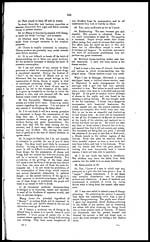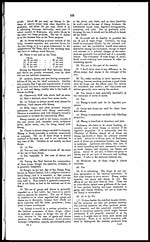Medicine - Drugs > Report of the Indian Hemp Drugs Commission, 1894-1895 > Volume V
(182) Page 162
Download files
Individual page:
Thumbnail gallery: Grid view | List view

162
Oral evidence.
Question 1.—I was educated at the Lahore
Medical School. I am L. M. and S. I have six
years and seven months' service, all in the North-
Western Provinces and Oudh. I have had no
special experience of insanity cases.
Question 7.—The cultivation I refer to is culti-
vation in the fields, not sparse cultivation here and
there in baris. By cultivation of the hemp plant,
I mean a hemp plant from which charas was
produced. I am a resident of Almora and speak
from my home recollections. I cannot give any
accurate idea of the extent of the cultivation. It
is not in every village but in some villages. It
is used (I was told) for fibre as well as charas. I
understood that it was more for the fibre and
seeds than for charas that it was cultivated. The
people extract oil from the seeds and use them as
spices. The seeds are sold in the bazar as well
as privately used. They call the seeds Bhan-
gobhij. The oil is not sold in the bazars. I can-
not say how much charas can be produced per
acre of cultivation. I cannot say whether the
charas produced in these districts is or any import-
ance as a commercial product.
Question 34.—I knew a Brahmin who was a
priest in the town of Almora, belonging to a re-
spectable family. He was in the habit of smoking
charas four or five chillums a day. I cannot say
how long he had smoked. He was looked down
on; and some of his relatives spoke strongly of
it. He went away from Almora for a month.
After his return he never smoked again. He
does not smoke now, not for these seven years.
I last saw him three years ago. He was not
then indulging. This is the only case I can re-
member as having been seen by myself; but I
have heard of others. There are also some people
who begin to smoke at the beginning of the cold
weather, keep it up during the winter months,
and abandon it in the summer months. I have
seen such cases. These people do not take bhang
in the hot weather. Few people take bhang with
us. They take only tobacco in the hot weather.
Question 35.—I do not know the amount of
charas imported nor the extent to which charas is
produced locally; and I can give no idea of how
far the local drug would supply the loss of the
foreign charas if the latter were prohibited. But
I have no reason for thinking that the amount of
the local charas is considerable.
I think that there is some moral restraint operat-
ing against drink at present: social and other re-
straints. But if the cheaper and less harmful drugs
were prohibited, more would resort to alcohol.
For the social prejudice against alcohol operates
to make them choose drugs in preference; but then
they would be driven to take to drink. There is
public opinion against charas-smoking. It is not
very strong, The feeling against liquor is decided-
ly stronger. I think drink much more harmful
than the drugs. Bhang I think practically
harmless. But liquor is, I think, much more harm-
ful than charas even. I think that the former
produces permanent changes of a mischievous
character. This has not been proved about
the drugs, I am not prepared to say that the
drugs do not produce such changes. My experi-
ence is very limited in regard to the evil effects
of either. I am unable to compare opium and
hemp drugs. I have not experience to enable me
to do so. I know of no books dealing with the
permanent effects of hemp drugs. I have myself
seen no such effects. I conclude therefore either
that there are no such effects, or that the matter
is not systematically treated. I have seen asylum
reports but not read them carefully. I am clearly
of opinion that alcohol is more deleterious than
hemp drugs. In reference to my answer No.
45, I may say that I did not make any enquiry
as to whether the bronchitis or asthma was really
due to charas; and as a fact people suffering from
these complaints often take charas for relief.
The oil referred to in answer 35 is used for
eating as a substitute for ghi.
Question 56.—In my opinion in cases of bhang
the pupils may be dilated or normal. They would
be less dilated than with dhatura. I have seen
cases of charas and bhang poisoning. My
experience is that the pupil is not contracted.
But I do not know much on this point.
110. Evidence of ASSISTANT SURGEON PURNA CHUNDRA. MUKERJI, Brahmin,
Kashipur, Terai.
1.By consulting with the residents of the place,
native hakims, and habitual consumers of these
hemp drugs, I have been able to answer these ques-
tions.
2.Yes, bhang or buti, ganja, charas, attar or
sulfa.
3.Bahraich, Terai parganas of the Naini Tal
district, particularly the parts nearer the hills
called Bhuksar.
4.Bhang plant.
5.Not properly known.
6. Dense, rarely scattered.
7.No; hemp plant grows spontaneously here
and is used for the production of bhang only.
10.No special class of cultivators.
11.Not known.
12.Nowhere, as far as my knowledge goes.
13.Not known.
14.Bhang only, about 200 to 300 maunds
annually, in the Terai, Bhaksar.
16.Bhang is almost always prepared by the
people in their houses, It can be prepared from
the hemp plant wherever it grows. No: ganja
and charas require a special method of preparation
and cannot be produced from every sort of hemp
plant.
17.No special class.
18.Yes, they do deteriorate, although they do
not quite lose their effects in time. Bhang and
charas could keep good for about one year, if pre-
served with ordinary care. Dampness and mois-
ture are the causes. Preservation in dry and
warm place will prevent deterioration.
19.Always used for smoking,
20.Ganja smoking is not prevalent in the
Terai; but charas is largely consumed, especially
by the working classes and fakirs.
22.Foreign exclusively, imported from Yar-
kand (Kabul) and Chaugarkha (Kumaun).
23.Never.
24.It is not confined to any special class of
Set display mode to: Large image | Zoom image | Transcription
Images and transcriptions on this page, including medium image downloads, may be used under the Creative Commons Attribution 4.0 International Licence unless otherwise stated. ![]()
| India Papers > Medicine - Drugs > Report of the Indian Hemp Drugs Commission, 1894-1895 > Volume V > (182) Page 162 |
|---|
| Permanent URL | https://digital.nls.uk/75121365 |
|---|
| Description | Volume 5: Evidence of witnesses from North-Western Provinces and Oudh and Punjab. Answers from witnesses in North-Western Provinces, Oudh and Punjab about cultivation and growth of hemp, preparation or manufacture, trade, consumption or use, effects, administration - taxation and control. |
|---|---|
| Attribution and copyright: |
|




